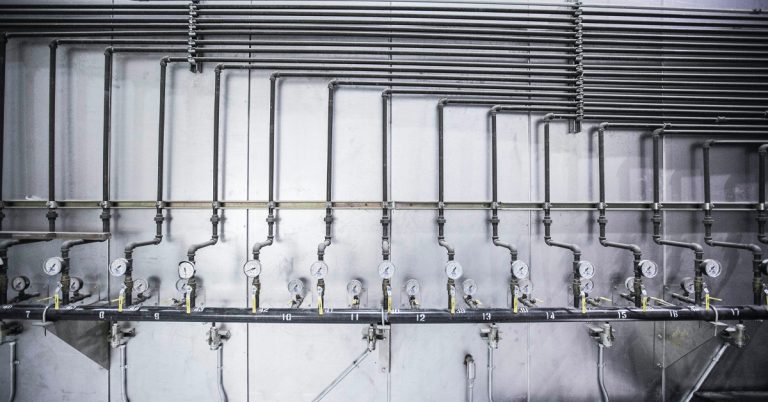Edwards Deming once said, “What cannot be measured, cannot be improved”. This truth bomb cannot be overlooked by manufacturing business managers. To increase your productivity and profits, it is important to hone in on a few manufacturing KPIs Key Performance Indicators.
Tracking processes that do not affect your enterprise’s performance can lead to monitoring meaningless dashboards. It is important to ensure you are measuring the right success indicators in the most critical areas of your business.
To help you implement the best KPIs for your company, we outlined some of the most meaningful KPIs for manufacturing. These indicators will help provide the framework to measure your progress and stay on track.
Table of Contents
What is a manufacturing KPI?

A manufacturing Key Performance Indicator (KPI) or metric is a well-defined and quantifiable measure that the manufacturing sector uses to measure its performance over time. KPIs are used to monitor, analyze and optimize operations, often comparing their efficiencies to those of their competitors.
There are about 30 manufacturing KPIs and metrics to use in your 2021 reporting. Learn how they are calculated and how you can streamline your reporting process in this post.
Importance of manufacturing KPIs

The manufacturing industry represents more than 15 percent of the global GDP. This fiercely competitive industry makes it imperative for manufacturers to implement KPIs and metrics to stay ahead of others.
Most businesses strive to increase the top line, trying to gain more market share to increase profits. While this is important, you could also grow your bottom line without having to take on expansion risks. This is where KPIs for the manufacturing industry come into play.
Top 15 manufacturing KPIs and metrics you should be tracking in 2021

When you start implementing manufacturing KPIs, the whole concept can seem complex. In this blog, we have tried to break down everything into smaller, more digestible morsels of information. We will start with 10 basic examples of KPIs in manufacturing that your company should consider using.
1. Throughput
This is one of the most fundamental and one of the most important KPIs for the manufacturing industry. The Throughput KPI measures the production capabilities of a machine, line or plant, i.e., how much they can produce over a specified period.
Throughput = # of Units Produced / Time (hour or day)
2. Cycle time
In the manufacturing industry, cycle time is the average amount of time it takes to produce a product. The cycle time metric can be used to measure the time it takes to manufacture a product, each individual component of the final product or even go as far as to include delivery to the end-user. It can be leveraged to analyze the overall efficiency of a manufacturing process on the macro scale, as well as on a micro-scale.
Cycle time = Process End Time – Process Start Time
3. Demand forecasting
This metric is used to estimate the amount of raw materials that will be needed to meet future customer demand. This metric can be a little bit trickier for companies to fully utilize, as it is highly dependent on uncontrollable external factors. There is a basic formula to calculate demand forecasting.
Projected Customer Demand = Raw Materials * Production Rate
4. Inventory turns
This is a measure of how many times inventory is sold over a specific period and helps indicate resource effectiveness. Low ratio numbers indicate poor sales and excessive inventory, while high ratio numbers represent strong sales or insufficient inventory.
Inventory Turns = Cost of Goods Sold / Avg. Inventory
5. Production attainment
This metric measures production levels over a specific time period and calculates what percentage of the time a target production level is achieved.
Production Attainment = # of Periods Production Target Met / Total Time Periods
6. Cash-to-Cash cycle time
This is a time-based manufacturing KPI metric. It measures the amount of time it takes from an initial cash outlay for raw materials, inventory or a manufacturing plant until the company receives cash from its customers for its products. This KPI is typically measured in days.
Cash to Cash Cycle Time = Inventory Sale Date – Inventory Purchase Date
7. Avoided cost
The avoided cost manufacturing metric is an estimate of how much money you saved by spending money. The most common example is how much money is spent on machine maintenance vs. repair cost if a machine were to break down, plus the lost production value associated with the repair downtime.
Avoided Cost = Assumed Repair Cost + Production Losses – Preventative Maintenance Cost
8. Changeover time
Put simply, changeover time represents the amount of time required to switch from one task to another. In manufacturing, it amounts to the amount of time lost from switching a production line from one product to another. However, it can also represent the amount of time lost during a shift change.
Changeover Time = Net Available Time – Production Time
9. Takt time
Takt time is the maximum permissible amount of time that can be spent manufacturing a product while still meeting a client’s deadline. Takt stands for “taktzeit,” a German word meaning “cycle time.” While similar in nature, this is not to be confused with the cycle time KPI.
Takt Time = Net Available Time / Customer’s Daily Demand
10. Return on Assets (ROA)
This metric evaluates how well your business is making use of its assets (money). It is the annual net income divided by total assets (fixed assets + working capital).
ROA = Net Income / Avg. Total Assets
11. Machine downtime rate
This metric gives a general snapshot of how an operation is going and not a full picture. Machine downtime is a combination of both scheduled downtime and unscheduled downtime.
Machine Downtime Rate = Downtime Hours / (Downtime Hours + Operational Hours)
12. First Pass Yield
This KPI is one of the most fundamental. It calculates the percentage of products manufactured to specification the first time through the process. This means that they do not require any rework or become scrap. A higher FPY rate is very desirable for any company.
First Pass Yield Rate = Quality Units / Total Units Produced
13. Overall Equipment Effectiveness (OEE)
This is considered the gold standard for measuring manufacturing productivity. The higher your OEE, the more effective your equipment is. A score of 100 percent means that you are manufacturing 100 percent of the time, at 100 percent capacity, at a 100 percent yield (no defective parts).
OEE = Availability * Performance * Quality
14. Manufacturing Cost Per Unit
It is important that you know the total cost associated with manufacturing a product on a per-unit basis. Without it, pricing a product is difficult. This KPI considers all costs associated with production and divides the cost by the number of units manufactured. Typical costs include materials, overhead, depreciation, labor and so on.
Manufacturing Cost Per Unit = Total Manufacturing Cost / # of Units Produced
15. On-Time Delivery
An especially important KPI in the manufacturing sector. This metric measures the percentage of products delivered on time to clients.
On-Time Delivery = (# Units Delivered On-Time * 100) / # Units Delivered
Metrics for the best manufacturing KPIs

There might even be the possibility that a standard manufacturing metric does not even exist for what you want to measure. If you are going to create your own production metric, there are the things you should take into consideration.
- Every KPI needs a clearly defined goal. What are you trying to achieve? Is it even something that can be achieved? What is the time that you wish to achieve this goal? Be specific and set up parameters that clearly define your goal. This goal needs to be something that can be numerically defined.
- It is important that you objectively measure your progress toward the goal. This means collecting and interpreting data.
- There must be a clearly defined data source with a strict procedure of how the data are measured or collected
- Reporting your data is just as important as collecting it. Typically, reporting should happen on a weekly or monthly basis, and will often make use of a manufacturing reporting software solution.
Now that we have a grasp of what makes a good KPI, we can dig a bit into the world of how to keep track of your KPI data.
How to keep track of your KPI data

Quality control and process management are the backbone of the operation. After companies start to implement their newly created KPIs and metrics, they often keep track of the collected data using Excel. However, there are a couple of things to take into consideration when managing your data.
- Data protection and security are essential. It is critical that your data is backed up and cannot be deleted by accident.
- Reduce the amount of duplicate data. Do not keep multiple copies of the same data. It is a good practice to have one working copy and one unaltered backup.
- Ensure your KPI data is easily accessible to your team
All these concerns can be remedied with a reporting solution.
Manufacturing dashboards to streamline your reporting

Regardless of whether your manufacturing company is large or small, using a manufacturing dashboard can bring a considerable difference in your operations.
- Managing large data dumps manually is an inefficient process. A manufacturing dashboard can automatically process collected data and turn the data into analytics and insights.
- Consolidating the data in a central location can take a long time. Manufacturing reporting software allows companies to input all their information into a single centralized location.
- Interface with other services. All good business intelligence software will be able to interface with an ERP software of your choice.
- Instant updates at your fingertips. With a centralized database, manufacturing dashboards can immediately generate reports on performance, as well as send you alerts when a KPI starts to underperform.
It is important to remember that KPIs are not a one-time set-and-forget. They will require updating as your business grows and expands. Sometimes there are metrics that you do not think of when you start, but you need it along the way.
1. Health and Safety Incidence Rate
Workplace accidents and near misses do occur. This metric monitors the number of incidents or near misses over a given period (normally per annum).
Health and Safety Incidence Rate = (Number of Incidences * 200,000) / # hours worked by all employees
2. Employee Turnover
While employee turnover typically has a negative connotation associated with it, not all turnover is bad. Some turnovers may be required to remove underperformers and replace them with higher performers.
Employee Turnover Rate (%) = (Employees who left * 100) / Avg. # of Employees
3. Customer Returns (Rejects)
This is a classic KPI still used to this day. Keeping track of returns is imperative. This metric calculates the percentage of products that customers return if they have received a defective product. A company should strive for the lowest percent possible.
Customer Return Rate = (# of Products Returned * 100) / Total # of Products Shipped
4. Total Manufacturing Cost Per Unit Excluding Materials
This is a performance metric that attempts to pin down the fixed costs associated with operating a factory or production line. These are the costs that companies can control.
TMC Per Unit Ex Materials = TMC Per Unit – Material Cost Per Unit
5. Manufacturing Cost as a Percentage of Revenue
This manufacturing KPI will help bring insight into how much your company is spending on manufacturing with respect to total revenue. This is extremely useful data to compare against competitors in the same sector.
Manufacturing Cost as a Percentage of Revenue = Total Manufacturing Cost / Total Revenue
6. Scrap Rate
This is a straightforward manufacturing KPI. It keeps track of the number of products that are deemed scrap due to manufacturing defects that cannot be reworked. It gives companies insight into the ratio of products deemed scrap, helping identify an inefficient process.
Scrap Rate = # of Scrap Units / Total # of Units
Leading and lagging indicators
Before you finalize the list of KPIs that you want to have prominently represented in your BI dashboard, you should consider adding both leading indicator KPIs and lagging indicator KPIs.
A leading indicator KPI is a method of measuring the inputs that are needed to meet your company goals. For example, if you want to add 50 more customers in the next quarter, you might measure KPIs such as percent of leads closed, amount of money spent on diverse types of advertising and so on. By grouping and analyzing these metrics, you can find trends that affect how rapidly you gain customers.
A lagging indicator measures the results of your efforts. In the example above, the lagging indicator would be the addition of 50 customers in the next quarter. The lagging indicator is the result of your actions. They are easy to measure, yet they can be difficult to drill down if an improvement is needed or if you are trying to discover the methodology that leads to success.
It is important to include both lagging indicators and leading indicators when developing your KPI strategy, as it helps you actively improve business by measuring quantifiable results.
Let data guide you
If you have made it this far, you may be interested in our guide on the “The Ultimate Business Intelligence Implementation Checklist Every CIO and Data Head Needs” which documents all permutations and combinations for your business intelligence implementation and data governance practices. Choosing the right Business Intelligence solution for your business can make or break the data analytics success story for your business.
This e-book offers a checklist for selecting the most appropriate BI platform for your needs. It helps your organization better evaluate its alternatives and assists your evaluation team in making an intelligent and appropriate choice.
[embedyt] https://www.youtube.com/watch?v=XS2b_rxkwMY[/embedyt]
[mailerlite_form form_id=1]
















